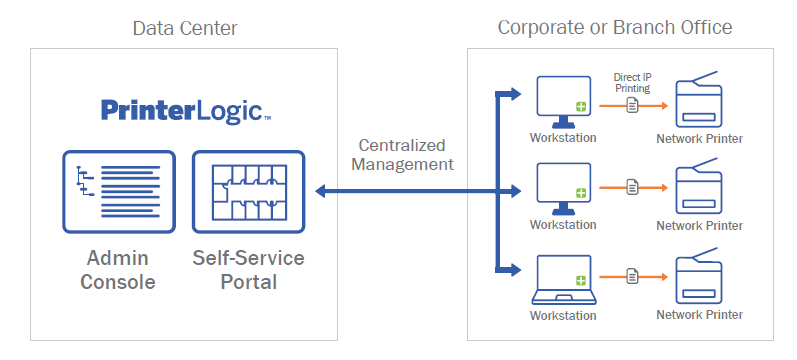The adoption of pull printing has really hit the mainstream in the past couple of years. In 2015, a study by research firm Quocirca found that 47% of all surveyed organizations had already deployed pull printing in some form or were planning to implement a pull-printing solution within the next year.
Based on our anecdotal experience here at PrinterLogic, interest in pull printing has certainly seen a rapid increase. These days it seems like many of our current and prospective customers have either rolled out pull-printing solutions or are actively looking for one. Part of that can be chalked up to the greater awareness (and risks) of data breaches and print vulnerabilities. Small wonder that, two years after its 2015 study, Quocirca published a paper recommending secure pull printing as an essential part of print security best practices.
Pull Printing: The Basics
For the uninitiated, pull printing generally looks like this: The user who wants a hard copy of a document clicks “Print” in the same way as they normally would. But instead of the print job winging its way to the selected printer to be printed out as soon as possible, it’s held in a special pull-printing queue. The user can then use a release mechanism, such as the printer’s control panel, to select and execute the job once they’re physically present at the printer. This second step can be performed at any printer that’s supported by whatever pull-printing solution the organization happens to have in place.
When the second step involves a stricter release mechanism that requires some form of user authentication, it’s sometimes qualified as secure pull printing. One common example of an authentication-based release is a PIN code or a badge/card reader such as CAC/PIV.
Pull-Printing Benefits
At first glance, this two-step process might seem inconvenient, but nothing could be further from the truth. When they’re designed and implemented correctly, pull-printing solutions are usually a win-win for everyone involved.
- More flexibility: Users get to choose their destination printer based on their actual circumstances. Ever sent a print job to Printer #1, then realized that it would have been much easier to pick it up at Printer #2? That happens all the time in large organizations, especially those with roaming and mobile users. One of the many pull-printing benefits is that users can release the job when they’re ready and in the most convenient spot.
- Less waste: It’s widely accepted that about 20% of print jobs end up in the recycle bin. This includes jobs that are printed by mistake, re-printed multiple times after minor edits are made, plus jobs that are forgotten and abandoned in the printer’s output tray—which, incidentally, is a huge security risk. The two-step pull-printing process makes printing more intentional, so that jobs are less likely to be abandoned. It also gives users a “delete” option if they realize their digital document needs more fine-tuning before being turned into hard copies.
- Increased security: The authentication mechanism that forms the basis of secure pull printing helps to ensure that the only eyes on a printing document belong to the end user who initiated the job. This is useful in HR departments, government agencies, as well as in EMR/EHR healthcare environments where confidentiality is of the utmost importance.
Implementing Your Pull-Printing Solution
If that’s piqued your interest in pull printing, well, here are the caveats. The nuts and bolts of implementing any pull-printing solution will depend on which solution you choose. Some are designed to work only with specific brands or models. Some might be wedded to a particular OS. They might offer most or even all of the pull-printing benefits outlined above, but it’s not guaranteed that those benefits will be available to every user in your organization. And it’s not safe to assume that the implementation will be seamless, even in an environment that meets all the solution’s basic requirements.
PrinterLogic’s secure pull-printing capability avoids those limitations, resulting in a single solution that can be deployed strategically across the organization to deliver all the pull-printing benefits without the usual list of caveats. Even managed service providers (MSPs) can use it across their entire customer base to add value to their services. As EPIC Management discovered, PrinterLogic’s pull-printing solution was versatile enough to be deployed seamlessly in its customers’ demanding healthcare environments, many of which were complex and Citrix-based, while also providing the security they needed to comply with guidelines on EMR and protected health information (PHI).
Secure pull printing from PrinterLogic works with three different release mechanisms—badge/card, control panel, and browser-based—to authenticate and execute pull-print jobs conveniently, efficiently and securely. To discover how effective it is in reducing print waste while introducing added print security and flexibility, download a full-featured trial of PrinterLogic and test it free of charge in your own environment for 30 days.
